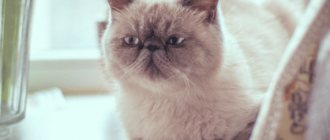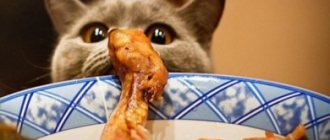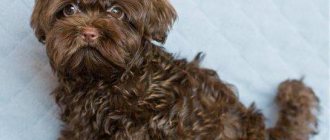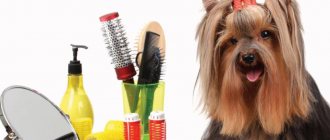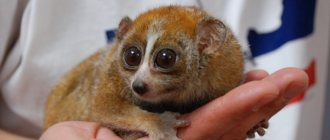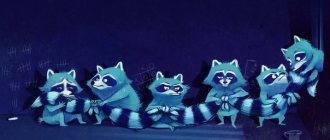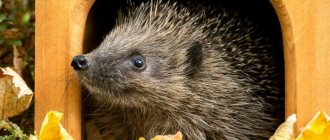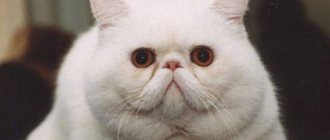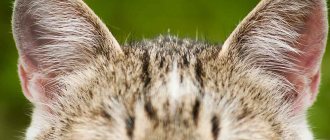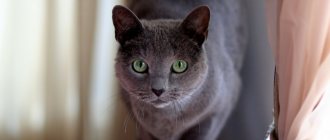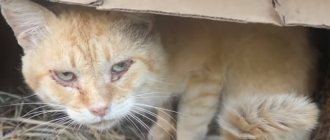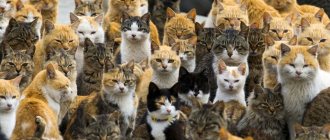If you ask people who have chosen a Ragamuffin cat, you will hear the following reviews: a simple and wonderful pet, a sociable and loyal friend, a healthy and imposing pet - all this is combined in a beautiful, affectionate animal. A simple origin story does Ragamuffin cat very close and understandable. The bright, impressive appearance, so characteristic of this breed, pleases owners and attracts everyone's attention at every cat show.
Video
* We invite you to watch a video about the Ragamuffin . In fact, in front of you is a playlist in which you can select and watch any of 20 videos about a given cat breed by simply clicking on the button in the upper right corner of the window. In addition, the material contains quite a lot of photos. By looking at them you can find out what Ragamuffin looks like.
Rate the material!
[Total votes: 0 Average: 0]
The Ragamuffin is a cat that originates from England. Thanks to crossing with various breeds (including outbred ones), Ragamuffins acquired strong immunity and good health. These are cats with a rich history and unusual character. They become attached to their owner, love children and have a calm, peaceful character.
Origin story of ragamuffins
The ancestor of the Ragamuffin breed was the breed of popular American cats - Redgalls. The translation of the unusual name is ragamuffin, which refers to the unusual appearance of cats - “rag doll” or “ragamuffin”. The cat breed was created by the popular breeder Anne Baker back in the 60s of the last century.
The ancestor of the Ragamuffin breed is considered to be the cat Josephine, who did not have any known origin. Most likely, the cat had a mixture of Persian and Angora roots. In the seventies, Ann Baker founded the Redgall organization, an association of cat lovers that established strict standards for the breed.
Deviations began to appear among the standards, so a split occurred in the association. Some breeders began to cross Redgalls with Persian, Himalayan and outbred cats, which increased their genetic potential and health. This is how the Ragamuffin breed came into being. The name of the Ragamuffins could have been different - Liebling, but they chose the latter because it conveys the origin of these cats.
Interesting fact: Ragamuffins did not immediately acquire their standard. In many ways, these cats have free characteristics, among which there are only a few established rules. Thanks to this, ragamuffins retain their individuality.
Ragamuffins have not gained the same popularity as Redgalls. This was influenced by the status of the Red Goll breed and the famous name of their breeder. Nevertheless, they still found their audience, since they had undoubted advantages over many other cat breeds.
How the breed appeared
For those who are only indirectly familiar with the English language, the name of the breed may seem, at first glance, rather “sweet”. The well-known word “muffin” catches your eye, and images of fragrant buns or cupcakes with raisins immediately appear in your head. However, in reality everything is not so simple. After all, among the English, a ragamuffin is a ragamuffin and a tramp. For fluffy and charming purrs, this name seems unexpected. However, after studying the history of the origin of the breed, everything falls into place.
It all started with the fact that in 1963, Persian cat breeder Ann Baker, living in the town of Riverside (USA), drew attention to a flock of yard cats. They were regularly fed by a neighboring family. Among these purrs was Josephine, who gave birth to beautiful long-haired kittens with an affectionate character in each litter. And although the fathers of each group of animals were different, according to Ann Baker, the cats inherited their friendly disposition from their mother. This circumstance was connected with the fact that the cat was rescued and people were coming out after a car accident. The breeder decided to consolidate such interesting features and develop a new breed from the street cats born to Josephine.
It was decided to name the new breed Cherub, which means “Highest angelic rank” in the Christian religion. However, Mrs. Baker set very strict demands for the clubs:
- only the founder herself could choose representatives for breeding the breed;
- decisions regarding matings also remained with the breeder.
Such control was not to the liking of many who wanted to breed the breed. And in 1967, a group of breeders decided to independently develop “cherubs”. To emphasize independence from Ann Baker, the name was changed to "Ragdoll". The main focus was obtaining additional types of animal coat colors. However, the breeder did not ignore this process. And, having changed the original name “Cherub”, she patented “Ragdoll” as the official one. From then on, kittens could only be used under Mrs. Baker's breeding program.
Ragdoll - the founder of the Ragamuffin breed
20 years later, having gone through numerous courts and disputes with breeders, the founder of the breed decided to leave breeding work. In 1993, the International Ragdoll Cat Association almost succeeded in taking control of the breeding of these fluffy purrs into its own hands. However, at the last moment Mrs. Baker changed her mind. And she began to breed another breed, crossing ragdolls with outbred long-haired cats. As a result, a large female was born, distinguished by its beautiful colors and unlike other “cherubs”.
This state of affairs was not to the liking of the breeders. Because of this, since 1994, some breeders have continued to develop the Ragdoll breed. And other breeders focused on distributing new “cherubs,” which were given the name “Ragamuffin” in honor of their outbred street ancestors.
Ragamuffin - description of the breed
According to the standard, the body of ragamuffins is proportional and rectangular. The chest is wide, convex, strong shoulders and pelvis. The abdomen is dense, but a small soft layer of fat always forms below. It does not affect body weight and is mandatory for the breed.
Males weigh from seven to nine kilograms, females - significantly less: from four to six. The Ragamuffin's coat is elongated, but not too long, and is soft and silky. On the hind legs the hair is slightly longer than in other places. There is also a characteristic woolen “rim” around the neck and “whiskers” around the head and on its sides.
The head is wedge-shaped, slightly rounded, graceful, without corners or sharp transitions. The forehead and chin are smooth, the facial part is small and compact. Fluffy cheeks, long whiskers, and voluminous whisker pads create an expressive facial expression in this breed.
Ragamuffin eyes are large, expressive, and set far apart. They can be any color, but for mink and sepia types, the important eye color is sky blue, sea blue or yellow-green. Cats' ears are triangle-shaped, neat and slightly tilted forward. The top is smoothed and there is a small brush, reminiscent of Maine Coon brushes.
Paws of medium length, with large soft pink pads, provide good support for the massive skeleton of the cat. The hind legs are longer than the front legs. The tail is long and bushy, but in proportion to the body, tapering to a tip.
Deviations from the standard and defects
Deviations from the standard are most common in non-purebred animals. The following are considered defects or serious deficiencies:
- too squat body;
- clearly visible spine;
- the tail is short, with kinks or knots;
- very short stocky legs;
- elongated muzzle;
- a clearly visible transition from the forehead to the nose (“Roman profile”).
If there is at least one defect, you can not count on participation in exhibitions and competitions.
Popular Ragamuffin Colors
It is worth saying that Ragamuffin fur is unique. It is very dense and very soft, and can be of different lengths. People who have petted Ragamuffins claim that the fur of these cats is like silk. The fur layer has two rows and a dense undercoat, which is not inferior in length and density to the guard hairs.
Ragamuffins have completely different colors. This breed largely split off from the Redgall due to the fact that kittens of other colors began to appear. Therefore, Ragamuffins do not have a standard color. However, in some associations the most revered color is white.
The nose and paw pads must match the color of the coat. Only white Ragamuffins can have pink, bicolor, or multicolor paw pads. The eyes of Ragamuffins are necessarily bright, but also have no standards for color.
The most common colors of ragamuffins are as follows:
- Color point. This is a Siamese color with prominent points - points, on protruding parts of the body. The muzzle, ears, tips of the paws and tail are colored darker. In ragamuffins, this color can have different variations: brown, black, chocolate, reddish. The main thing is that the color of the body is lighter than the color of the points;
- Black ragamuffins are also common, but exclusively black ones without markings are extremely rare. Most often they have parts of the body painted white: chest, paws, muzzle or tail. Such ragamuffins are prized at exhibitions because they look very impressive;
- Tabby. A color in which very bright dark stripes or spots stand out against a main white background.
How to choose a kitten
First of all, you need to pay attention to the eye color of the little Ragamuffin. The richer and brighter the shade of the iris, the better. Purebred kittens have a strong rectangular chest, a long tail and powerful hind legs. The pet must be active, playful, and not afraid of people. You should be wary if he is timid and does not make contact. The nose and eyes should be free of discharge, dry and clean.
Character and habits of ragamuffins
Ragamuffins are peace-loving and sociable animals, although their character has a number of peculiarities. For example, Ragamuffins are endlessly devoted to the family in which they have lived since childhood. Therefore, it is not worth giving an adult cat to other people; he will never take root in someone else’s environment and will always miss his owners.
Ragamuffins are quite sociable cats. They get along well with other cats who are ready to make contact, but if aggression is shown towards them, the Ragamuffin will never take the initiative to get acquainted. Thanks to such a loyal character, these cats get along well with children and are even willing to tolerate playing with them.
Ragamuffins are smart. They are easy to train and have no difficulties in raising them. But there is an important nuance: the Ragamuffin should be the first animal you bring into your apartment. He should not feel competition from other animals, all attention should be focused only on him. Ragamuffins cannot tolerate dogs, so these two pets should not be kept together.
Ragamuffins cannot stand loneliness and separation from their beloved owner. He should not be left alone even for two days - the cat will get bored, become depressed and get sick. Ragamuffin must be taken with you on all long trips, including vacations. He won't be happy if you leave him to your neighbors or friends. It is useless to tame him to loneliness.
Interesting fact: Cats of this breed tolerate travel well. They happily explore a new area and feel protected if their owner is nearby. These cats have no developed hunting instinct at all, so they will not run after prey.
Ragamuffins love to please their owners, so they happily learn tricks and follow established rules of behavior. These cats are discreet and intelligent, so they will not spin around underfoot or scream loudly, attracting the attention of the owner.
Interesting facts about ragamuffins
The fat fold under the belly of cats is formed only by two years. Because of this, some owners begin to think that the animal has gained too much weight and put it on a diet, which is not worth doing. A fat fold is a characteristic and normal phenomenon for this breed.
Depending on the time of year, the thickness and structure of the Ragamuffin's coat changes. For example, cats shed heavily during the summer, shedding almost all of their undercoat. And the fur reaches its greatest thickness and smoothness by the age of three in the winter. Over the years, the wool becomes dull and becomes more porous, so Ragamuffins look much darker in old age than they used to be.
Not all representatives of this breed have lynx ear tufts. They are not a requirement of the standard, but are highly valued at exhibitions. White ragamuffins with tassels on their ears are especially valuable.
Ragamuffins may be disqualified based on multiple characteristics that do not match. Firstly, the body is too long or too short, the legs are long, the coat is short or curly. The tail should be straight and long. The cheekbones or cheeks are clearly visible on the head, and the nose has a hump. Also, cats of this breed are characterized by squint, which is not a good sign.
The Ragamuffins were called "rag dolls" for a reason. These cats love to be held, even if the position is not entirely comfortable. They are easy to handle being picked up and carried by children - they even love it. Ragamuffins themselves willingly climb into their arms and purr on their knees. Ragamuffins even allow children to wrap themselves in “swaddles” and babysit them.
These cats understand which animals can be hunted and which cannot be touched. Thanks to their sociability, Ragamuffins get along with guinea pigs and parrots - they are even happy to communicate with other animals.
All Ragamuffins are born white. Their fur acquires a certain color only at three or four months.
Pros and cons of ragamuffins
The advantages of the Ragamuffin breed include:
- Calm temperament, peacefulness. Ragamuffins are very tactful with both family and new people. This extends to their attitude towards animals and children;
- Ragamuffins are not noisy animals at all. They rarely meow, do not get in the way, and are not inclined to misbehave. The maximum that these cats can do to attract the owner’s attention is to gently touch him with their paw or purr quietly;
- Representatives of this breed completely trust their owners and treat them with all tenderness and kindness. Ragamuffins will always be confident that their people will not harm them and will treat them well;
- Cats are patient, so they get along well with other animals and children, with the exception of dogs. The main thing is that the Ragamuffin feels that he is loved - this way he will not be jealous of the owner of other pets;
- Ragamuffins are well trained and quickly learn the rules of behavior in an apartment; They have good health and are not prone to illness.
The disadvantages of ragamuffins include:
- Ragamuffins are vulnerable and unable to stand up for themselves. They prefer to avoid conflicts, but if they happen, these cats cannot fight back;
- Ragamuffins should not be owned if you need a cat and mousetrap. They will not hunt, but rather become frightened by mice or other rodents;
- Ragamuffins are very afraid of water;
- They shed heavily, especially during certain periods. Their coat needs good care;
- Ragamuffins are susceptible to stress. Therefore, they cannot be left alone for a long time, they cannot be scolded, frightened, and even more so, beaten;
- Adult cats are completely indifferent to what is happening around them. They don't play and try to move less.
Disadvantages and advantages of the breed
The pros and cons of the breed are listed in the table:
| Advantages | Flaws |
| Developed intelligence | Inability to walk independently |
| Peaceful calm disposition | Intolerance of loneliness |
| Devotion not only to the owner, but to all family members | Tendency to a number of genetic diseases |
| Difficulty in purchasing a kitten and its high price | |
| Possible allergy to animal fur |
The Ragamuffin is a friendly and active pet that can become a devoted and loyal friend. He is unpretentious in everyday life, but his health requires attention.
Ragamuffin breeding
Females and male cats that have reached the age of three years are allowed to breed. Animals must be absolutely healthy, including those without internal parasites. All vaccinations must be included in the animal's passport. Male and female cats are listed as the same breed because interbreed matings are not allowed for Ragamuffins.
Due to their nature, Ragamuffins are not aggressive and are sociable. Cats, even sensing the cat's heat, behave very courteously and even shyly, so the animals may need a lot of time to get to know and get used to each other. Therefore, the Ragamuffin cat will have to be brought to visit the cat several times until the animals communicate.
Interesting fact: If the cat is too shy, then it is better to start mating with an experienced adult cat. Cats are less careful, so they themselves willingly go towards cats.
As a rule, mating is productive. Ragamuffin cats have excellent health and proper physiology, so pregnancy is easy. Ragamuffins also give birth without difficulty, but it is important for them that a person be present during the birth - this makes the cats feel calmer.
Most often, six kittens are born, but sometimes eight. They are all white with barely noticeable tints. When kittens open their eyes, the healthiest ones can be identified by the richness of the color of their eyes - they should be bright blue. Ragamuffin kittens are strong and strong; from birth, their wide chest and developed paws are noticeable, and the pelvic bones should be exactly the width of the shoulders.
At the sixteenth week, the kitten acquires an appearance most similar to that of an adult cat. Its color becomes clear, the outlines of the skeleton appear. In total, ragamuffins live on average up to sixteen years.
Caring for Ragamuffins
Although Ragamuffins have the thickest fur with three layers, they are not as difficult to groom as similar furry breeds. It does not fall into lumps and tangles, but simply falls out, and it should be helped with this. The cat must be brushed daily, using a large brush with long, sparse teeth. When the Ragamuffin begins to shed, the coat needs to be brushed several times, using brushes with different tooth frequencies.
Ragamuffins should not be bathed more than once a year. These cats have a very bad attitude towards water, and every bath is a huge stress for the cat. Ragamuffins themselves take good care of the cleanliness of their fur, and if the pet gets its paws dirty, it is better to wipe it with a napkin moistened with warm water. If there is a need for bathing, then you need to use special shampoos and balms for cats with long hair.
Important fact: Ragamuffins' eyes and ears need to be cleaned once a week. There may be discharge from the eyes, which is normal for this breed, and excess wax from the ears must be removed.
Ragamuffin teeth require special care and need to be brushed daily with special toothpastes. Otherwise, the cat may develop periodontal disease. Claws should be trimmed about once a month so that they do not impede the cat's movements. Since Ragamuffins are easy to train, from childhood it is worth accustoming him to a scratching post, which will itself sharpen his claws.
You need to take a ragamuffin for a walk. If you have a private house with good fencing, then you can let him go alone; the cat will not go outside the house due to his characteristic fear. When walking down the street, you should not go far from the animal; the Ragamuffin can get scared of anything and run away.
How much does ragamuffin cost and where to buy it?
The main nurseries of the Ragamuffin breed are located in the United States. There are registered breeders in Canada, South Korea, England, the Netherlands, Bulgaria, Austria, but there are none in the former CIS countries. It is possible that Ragamuffin cats are bred by the owners of Ragdoll nurseries, of which there are many in Russia, including in Gomel and Kyiv. The availability of children and their cost must be determined individually.
Purebred Ragamuffin
Prices for the breed start at $850 or more. For a kitten with a good pedigree and high quality indicators you will have to pay from $1,500. From private owners you can find a kitten at a more affordable price ranging from $550-800.
Ragamuffin diet
Ragamuffins are best fed with a special premium food for large cats. Such food is balanced and contains a sufficient amount of useful elements to keep the cat healthy and beautiful. You should immediately abandon cheap feeds, as they provoke various diseases.
Natural feeding of a long-haired cat is possible if it is properly balanced. Ragamuffins need a huge amount of protein and fiber. In addition, most of the diet is meat, since although Ragamuffins have lost their hunting instincts, they are still predators.
We stick to the following foods that are rich in protein and fiber:
- Veal, chicken, turkey - lean meat, raw or semi-cooked;
- Sea and ocean fish in small quantities;
- Fermented milk products, including low-fat cottage cheese and kefir;
- Any fruits and berries, with the exception of grapes and citrus fruits, should never be given to cats;
- Any vegetables, especially cucumbers;
- Cereals, except wheat and legumes, in a well-cooked form.
Be sure to consult with your veterinarian so that he can prescribe individual supplements for your cat in the form of minerals and vitamins. To ensure that food is well absorbed and as healthy as possible, it is worth serving it in small portions three to four times a day.
Since the stomach of long-haired cats easily becomes clogged with hair, it needs to be cleaned with special pastes. In addition to pastes, fresh herbs cleanse well - you can buy them in the store and grow them right on the windowsill.
Feeding the cat
Because Ragamuffins have fluffy fur that gets dirty when they eat, it is recommended that they be given commercial food. For cats of this breed, it is advisable to buy premium or super-premium drying, which does not contain soy, dyes or preservatives.
These requirements are best met by the following brands:
- Pronature;
- Bosch;
- Hills;
- Grandorf.
Important! Dry-fed ragamuffins should have easy access to clean drinking water.
With a natural type of feeding, the menu for fluffy cats is designed so that it contains at least 70-80% meat. Ragamuffins are also given:
- boiled vegetables;
- porridge with water;
- boiled eggs;
- offal;
- sour milk;
- sea or ocean fish.
In order for cats of this breed to remain healthy and active longer, they should not be given pork, fresh milk, pastries, sweets and smoked foods. Also, ragamuffins should not be fed sausages, pickles, river fish, potatoes and leftovers from the owner's plate.
Diseases and health problems
The rich experience of crossing throughout the history of the breed has awarded Ragamuffins with excellent health and excellent immunity. These cats rarely get sick and rarely catch a cold, so you can safely walk down the street with them.
There are a number of hereditary diseases that can only be detected using a DNA test. Before crossing two individuals, testing should be carried out to show whether the offspring are at risk of developing these diseases. This disease is hypertrophic cardiomyopathy and hereditary polycystic kidney disease. Animals with these diseases do not live long.
Instead of having health problems, Ragamuffins have developed characteristics that set them apart from other cats. For example, loneliness can cause cats to become depressed, which can lead to other health problems.
Depressed cats are inactive, lose weight, and do not want to eat at all. Such cats are treated with antidepressants, but it is very difficult to treat Ragamuffin depression. When getting a Ragamuffin, you need to leave at least one more small pet with him, who will communicate with the cat.
Ragamuffins are very stressed. Fear can be fatal for Ragamuffins - they can permanently acquire a phobia and begin to flinch at any moment that reminds him of fear. A stressed animal may either eat a lot or refuse to eat, and the Ragamuffin will need even more presence from its owner.
Maintenance, care, health
This cat breed is distinguished by enviable health; its representatives do not have chronic diseases. It is important to get vaccinations on time, periodically prevent the formation of hairballs in the stomach, and everything will be fine with your pet.
Ragamuffin does not require much attention in terms of care, but some procedures must be carried out regularly. So, once every 2 days the cat must be combed with a special brush; during the molting period, this procedure must be done daily. It is also necessary to carry out standard procedures for caring for your pet’s ears and eyes; they must be wiped with a damp cloth soaked in boiled water.
